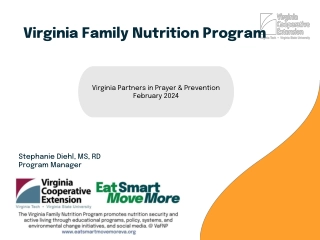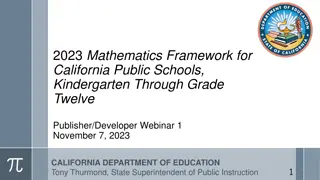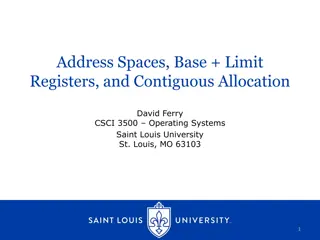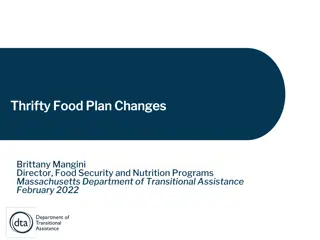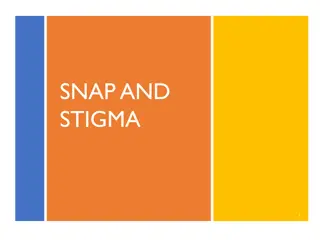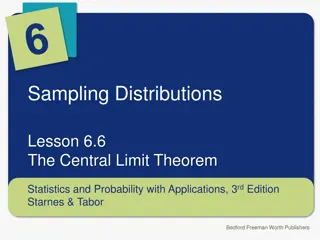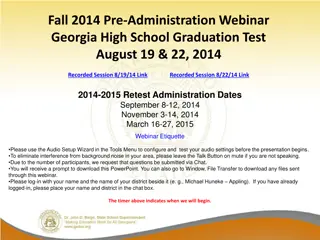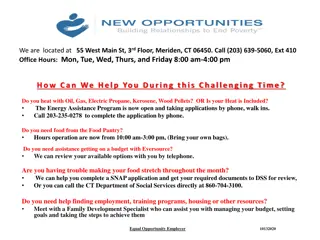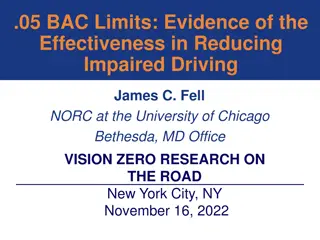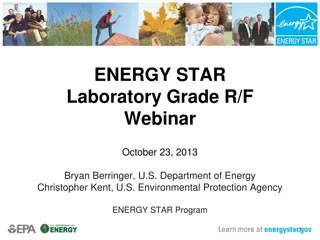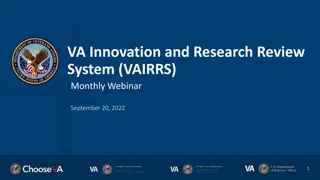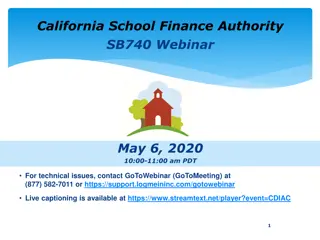Understanding the New SNAP Time Limit for ABAWDs: Webinar Overview
Explore the basics of the SNAP time limit rule for Able-Bodied Adults without Dependents (ABAWDs) in Pennsylvania, including exemptions, work/volunteer requirements, and ways to assist clients. Gain insights into the impact on vulnerable residents and learn about the key aspects of this federal rule effective from April 1, 2020.
Download Presentation

Please find below an Image/Link to download the presentation.
The content on the website is provided AS IS for your information and personal use only. It may not be sold, licensed, or shared on other websites without obtaining consent from the author. Download presentation by click this link. If you encounter any issues during the download, it is possible that the publisher has removed the file from their server.
E N D
Presentation Transcript
Webinar hosted by: Understanding the New SNAP Time Limit for ABAWDs Louise Hayes Supervising Attorney lhayes@clsphila.org www.clsphila.org Kathy Fisher Policy Director kfisher@hungercoalition.org www.hungercoalition.org Ann Sanders Public Policy Advocate anns@justharvest.org www.justharvest.org 1
Overview 1. Basics of the SNAP Time Limit Rule 2. Implementation in Pennsylvania How ABAWDs can qualify for exemptions How ABAWDs can comply with the rule through work and/or volunteer hours 3. Examples of Exemptions 4. Items still to be determined 5. What you can do to help clients now 6. Questions 2
The Basics The federal SNAP time limit for ABAWDs, so-called Able Bodied Adults without Dependents, goes into effect April 1, 2020 in almost all of Pennsylvania. An ABAWD is an individual between 18 and 49 years old who is not disabled, pregnant, or, receiving SNAP with a child under age 18. Those considered ABAWDs may only receive SNAP benefits for a total of 3 months in 3 year period, unless the individual: Meets an exemption, or, Complies with certain work or volunteer requirements Previously, this rule did not apply in most of the state because of high unemployment. Those areas can no longer be protected. 3
SNAP 3-month Time Limit: Who? The rule applies to so called Able-Bodied Adults without Dependents (ABAWDs). ABAWDs are individuals receiving SNAP who: o Are 18-49 years old o Does not receive SNAP with a child under age 18 (does not have a minor child as part of their SNAP household) o Are able to work 4
ABAWDs There are an estimated 92,000 across PA (34,000 in Philadelphia) They are some of our most vulnerable residents Many need additional training or education for today s jobs Nationally, almost 75% live in deep poverty (income below $12,140/year for one person) 5
SNAP 3-month Time Limit: What Is It? It is a federal rule that limits ABAWDs to 3 months* of SNAP benefits in a 3 year (36 month) period unless they: Qualify for an exemption Work or participate in a work program at least 20 hours per week (averaged monthly) Are in school or training at least half-time (must meet other eligibility rules for students) Volunteer or perform community service to work for benefits, usually for 26 hours per month Live in an area waived due to insufficient jobs (very few will be as of April 1) *Partial months of benefits do not count toward the 3 month limit 6
SNAP 3-year Time Limit: When? o Congress created the rule as part of welfare reform in 1996 o New rule goes into effect April 1, 2020; with a 3-month time limit, the earliest an ABAWD would lose SNAP is July o PA has carry-over exemptions from prior years it must use by end of Sept. o DHS is evaluating whether it can use exemptions to delay implementation in some counties that face a large impact (possibly Allegheny, Cambria, Fayette, and Philadelphia) o Even with delayed implementation, ABAWDs who can qualify for exemptions should report the reason(s) to the CAO as soon as possible o PA will have a limited number of exemptions each year and plans to use those to help particularly vulnerable ABAWDs keep their SNAP benefits 7
When does the 3-month period run? The 3-month clock starts with the first full month of SNAP benefits and adds to the count each full month benefits are received o If SNAP benefits are not received each month, the clock stops o The clock ends the last day of the third month Once an ABAWD receives 3 countable months of benefits, he/she will not be eligible again until: o The new three-year fixed period begins, OR o They regain eligibility by meeting an exemption or the work and/or community service requirement o They can get another 3 months if they ve worked 80 hours/month (even if they leave the job) 8
When does the 3-year period run? The 3-year clock is a fixed period for everyone in the state o The current 3-year fixed period is from Jan. 1, 2018 through Dec. 31, 2020 for the entire caseload o A new 3-year clock will begin Jan. 1, 2021 and run through Dec. 31, 2023 o Each fixed 3-year fixed period, an ABAWD can receive a new count of 3-months of benefits 9
SNAP 3-month Time Limit: Where? oMany counties in Pennsylvania have always qualified for a waiver from this rule oIn 2019, 63 of 67 counties in Pennsylvania, as well as a few smaller municipalities, were waived from the rule oStarting April 1, just two counties Forest and Mercer are expected to qualify for a waiver (Mercer will lose it Dec. 31, 2020) oThis is a tremendous change and challenge for PA and states around the country 10
SNAP 3-month Time Limit: Why? o Changes to the ABAWDs rule were considered by Congress during Farm Bill negotiations o Those changes were rejected when Congress passed the Farm Bill in Dec. 2018 o Instead, the Trump administration has used the rule making process to make this change o Areas now must have much higher levels of unemployment to qualify for a waiver 11
SNAP 3-month Time Limit: How? In the next section, we ll discuss: o How the rule will be implemented in PA o How you can help clients keep their SNAP Quick rule review: ABAWDs can get SNAP benefits for just 3 months in a 3 year period. To continue to get SNAP for longer, they must: o Qualify for an exemption o Work or participate in a work program at least 20 hours per week (80 hours/month) o Be in school or training at least half-time o Volunteer or perform community service for about 26 hours per month 12
Categories of Exemptions Now is the time to help individuals start to get their paperwork in if they qualify for an exemption. Exemption Explanation Unfit for Work *Medical professional certifies individual will have trouble working (or unfitness is obvious) Pregnancy Being pregnant (may need to provide proof) Meets another Exemption Additional exemptions are listed on slide 15 * See slide 14 13
Medical Exemption Form PA 1921 ABAWDs who cannot work due to medical reasons should have a medical provider complete an Medical Exemption Form o This includes those in drug or alcohol treatment or mental health treatment o The form should be submitted to the CAO as soon as possible o ABAWDs can also call the customer service center (Statewide: 877-395-8930; Philly: 215-560-7226) to ask that the form be mailed to them o Also available at www.clsphila.org/ABAWDS - or - www.hungercoalition.org/ABAWDS 14
Other Exemptions (These are the ETP exemptions on earlier slide) Homeless Cares for a child in the household under age 6 Experienced domestic violence Applying for or receiving Unemployment Compensation Cares for ill or incapacitated person in the same home (does not need to be same SNAP household) Travel to work, education, training, or volunteer site is 2 or more hours (round trip) Enrolled in school or training at least half time (must meet other rules for students) Migrant/seasonal farm worker expected to work within 30 days Expected to return to work within 60 days 15
Time Limit Implementation at CAOs SNAP applications & re-certifications* will include an ABAWD determination. CAO workers will review all individuals age 18-49 to determine what category they are in: The 3-month time limit applies Is not exempt and does not live in a waived area Has not met work, education, training or volunteer requirements Exempt Has met ABAWDs requirements Works at least 20 hrs/week averaged monthly Participates in an approved education or training program 20 hours/week* Performs community service or volunteers for required hours (typically 26 hours/month) *Job search does not count Has a child under 18 in the SNAP household Disabled or unfit for work Is pregnant Meets another exemption (see slide 15) * Re-certifications occur every 3 months, rather than annually, for non-exempt ABAWDs 16
CAOs will inform ABAWDs of Time Limit For individuals that do not meet an exemption during the SNAP interview, CAO workers are to: Explain that starting April 1, they can receive just 3 months of SNAP benefits in the 3 year period if they do not: o Qualify for an exemption Meet an ABAWD work, education/training, or volunteer requirement o DHS will mail ABAWDs a notice and survey (CM-558): When approved, informing them of the 3-month limit We are working to learn more about DHS exact process and pressing for clear and frequent communication to clients o o 17
ABAWD Exemption Example 1 For all examples, assume the person lives in a county where the rule applies. Derrick: 34-year-old man Lives with his girlfriend, Amber, and her 13-year-old son, Jeremiah They purchase and prepare meals together They apply for SNAP benefits and are found eligible Is Derrick an ABAWD? 18
ABAWD Exemption Example 1 No Derrick is not considered an ABAWD because he receives SNAP with Jeremiah, who is under age 18 (they are part of the same SNAP household) 19
ABAWD Exemption Example 2 Kevin applies for SNAP benefits for himself and his minor son, Cory, in July for that month Cory s mom has custody of him during the school year and receives SNAP benefits for Cory and herself Kevin has custody during the summer Kevin thinks the ABAWDs rule does not apply to him because of Cory. Is that right? 20
ABAWD Exemption Example 2 No Because Cory is already part of his mom s SNAP household, Kevin considered an ABAWD Kevin is subject to the 3-month time limit, unless: o Cory is under age 6 (meets the caring for a child under age 6 exemption) OR o Cory s mom agrees to let Kevin get SNAP for Cory in the summer 21
ABAWD Exemption Example 3 Janice is a single 47-year-old woman, has no children, lives in Philadelphia Applied for SNAP and has a mental disability that prevents her from working, but the disability is not obvious Was given a PA 1921 to have completed by her medical provider but has not returned it to the CAO Does she meet any exemptions? 22
ABAWD Exemption Example 3 No Janice does not meet any other ABAWD exemptions, and has not yet provided certification of her disability If she gets the PA-1921 filled out and submitted, she can remain eligible Community groups can help! (Many providers can sign the PA-1921) 23
Meeting required hours through work What if an ABAWD works fewer than 20 hours/week? If an ABAWD is regularly scheduled for less than 20 hours/week: If an ABAWD is scheduled for 20 hours/week but misses hours through no fault of his/her own (holidays, illness, transportation problems): o He or she must do other permitted activities, such a volunteering or training, to get up to 20 hours a week. o He or she should report this to the CAO, and ask for a GOOD CAUSE review so that he/she can continue to qualify for SNAP o Job search can count for up to 10 hours/week 24
Non-Work Activities that meet the 20 hour/week requirement Activities that can meet 20 hours/week requirement (alone or in combination): Advanced degree (college) classes Skill/Vocational training classes English-as-a-Second Language (ESL) classes Adult Basic Education (ABE)/ Literacy classes GED/High school remediation classes Work experience/vocational experience Programs through Career Links (WIOA programs) Community service/ workfare *Remember, those in school at least half time are exempt. They do not need to combine hours with other activities. 25
Community Service/Workfare ABAWDs can comply with the rule by volunteering with a non- profit or government site Required hours are the monthly SNAP grant divided by the minimum wage (the $194 maximum grant for one person, divided by $7.25 = 26 hours/month) ABAWDs will be allowed to find volunteer sites/opportunities on their own ( self-directed community service ) Details for how ABAWDs will report hours are still being finalized (we will update our websites when new information is available) Volunteer sites may be asked to sign a Community Service Agency Agreement (PA 1694 is currently being revised) 26
SNAP Employment & Training DHS has some employment and training slots to help ABAWDs comply and continue to receive SNAP There are a limited number of programs and slots, and some have specific requirements clients must meet to be accepted Clients who are interested must be referred to employment and training by the CAO He/she can ask at the CAO, or, call the customer service center and ask that a ticket be sent to their CAO worker for an E&T referral to start the process Statewide: 877-395-8930 Philly: 215-560-7226 27
Complying with Hours Example 1 Rose is a 35-year old single woman She receives full months of SNAP benefits in Aug., Sept., and Oct. and has a renewal interview on Oct. 21 At the interview, Rose reports having worked 20 hours in the previous week and expects to continue to work 20 hours/week The CAO verifies the employment Can Rose continue to receive SNAP? 28
Complying with Hours Example 1 Yes Rose is now meeting the work requirement Her SNAP eligibility now continues uninterrupted 29
Regaining SNAP After a Cutoff ABAWDs can reapply and get SNAP back if: Even if an ABAWD doesn t otherwise qualify, he/she can get another 3 months of SNAP if in any 30-day period since last got SNAP, have: o Become exempt o Meet the 20 hour/week work requirement (or work off the SNAP through community service) o Worked 80 hours, or o Participated in a training program for 80 hours o Move to an area with a geographic waiver A new 3-year period for all ABAWDs will start 1/1/2021. 30
Regaining SNAP Example 1 o Anthony is a 46-year old single man He receives three full months of SNAP benefits in Jan., Feb., and March, and benefits stop due to the time limit o Anthony reapplies for SNAP in Nov. of the same year and is now receiving unemployment compensation o His unemployment compensation income is within SNAP income limits o Is Anthony eligible? 31
Regaining SNAP Example 1 Yes Receiving Unemployment is a federal E&T exemption from ABAWD requirements Anthony s SNAP eligibility has been regained because he is now meeting an exemption SNAP benefits can be authorized on an ongoing basis 32
Recap: What you can do to help clients now o Inform clients this rule is coming o Help them understand the rule o Help them establish exemptions, including assisting with paperwork (like submission of the PA-1921) o Help them identify community service or volunteer opportunities o Some agencies may be able to provide community service/volunteer slots 33
Additional Information & Updates For more information: o www.clsphila.org/ABAWDs o www.hungercoalition.org/ABAWDs Websites will be updated as new information becomes available Questions? Email: Lhayes@clsphila.org or kfisher@hungercoalition.org Coalition Against Hunger SNAP Hotline: 215-430-0556 Additional SNAP Hotlines: o Central PA Food Bank: 877-999-5964 (serving Central PA) o Just Harvest: (412) 431-8960 x 602 o Greater Pittsburgh Community Food Bank:1-833-822-SNAP (7627) (Southwest PA) o Second Harvest Food Bank of the Lehigh Valley: 866-203-3323 (Northeast PA) o Second Harvest Food Bank of Northwest PA 814-459-3663 x 118 (Northwest PA) 34


